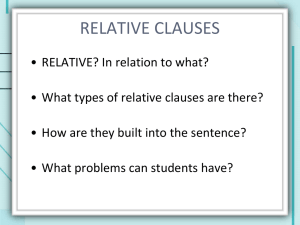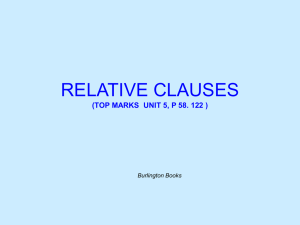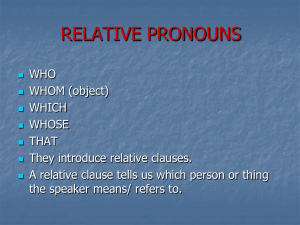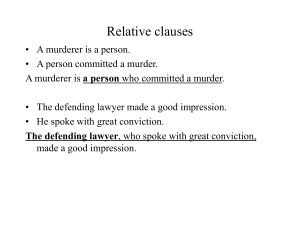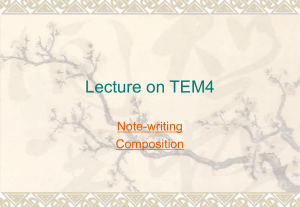2014-08-18 STABLISATION CLAUSES
advertisement
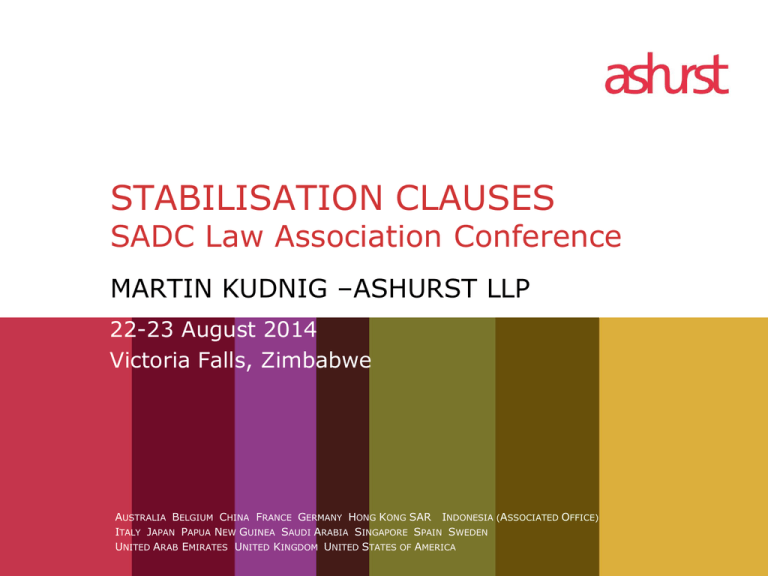
STABILISATION CLAUSES SADC Law Association Conference MARTIN KUDNIG –ASHURST LLP 22-23 August 2014 Victoria Falls, Zimbabwe AUSTRALIA BELGIUM CHINA FRANCE GERMANY HONG KONG SAR INDONESIA (ASSOCIATED OFFICE) ITALY JAPAN PAPUA NEW GUINEA SAUDI ARABIA SINGAPORE SPAIN SWEDEN UNITED ARAB EMIRATES UNITED KINGDOM UNITED STATES OF AMERICA Presentation by: Martin Kudnig, Partner (Solicitor, Victoria, Australia), ERI – London Direct line: +44 (0)20 7859 1679 Mobile: +44 (0)7825 277167 Email: martin.kudnig@ashurst.com Ashurst LLP Broadwalk House 5 Appold Street London EC2A 2HA Tel: +44 (0)20 7638 1111 Fax: +44 (0)20 7638 1112 www.ashurst.com 2 Overview • • • • • • • Introduction Stabilisation and Political Risk Types of Clauses Legal Effect Enforcement Investment Treaties, Political Risk Insurance, ECAs Trends 3 Introduction Rising demand for natural resources has led to many oil and gas and mining companies pursuing opportunities in emerging markets Mining projects characterised by long terms and high levels of investment Stabilisation clauses in investment agreements are designed to “fix” life of mine costs Challenge for developing countries is to establish a political and regulatory regime that is attractive to foreign investors but ensures sufficient benefits flow back to local economy 4 Stabilisation and Political Risk What is it? • Risk that political and/or financial instability in host state or government action may adversely impact the continued existence of the project or its capacity to generate revenue 5 How is the Risk manifested? • Expropriation or nationalisation • Failure/refusal of Government to grant permits etc. • Increases in taxes and royalties or removal of concessions • Impositions of exchange controls • Changes in law relating to health and safety, environment, local content etc. 6 Types of Clauses Freezing Clauses Balancing Clauses Designed to freeze the laws that apply to the relevant project to those applicable at the time initial investment agreement is executed Permit new laws to apply to project but investor to be compensated for costs of complying with new laws Hybrid Clauses Contains elements of both freezing and balancing clauses 7 Freezing Clauses • Full freezing clauses provide that all laws, both fiscal and non-fiscal, are frozen, usually for the duration of the project • Limited freezing clauses are designed to protect investor from changes to specific areas, usually fiscal changes (royalties often excluded) 8 Example of a Freezing Clause “The Investor and its Direct Sub-Contractors shall not be subject, in relation to the Project Activities, to any Tax (including, for the avoidance of doubt, export duties and taxes, VAT and capital gains taxes), which is not expressly provided for in this Agreement. By virtue of this Agreement, the Investor and its Direct Sub-Contractors shall benefit in relation to the Project Activities, from the stabilisation of the Fiscal and Customs Regime in force on the date of execution of the Agreement (including the provisions of this Agreement) throughout the term of this Agreement.” * * Agreement between the Republic of Guinea and Global Alumina Corporation in relation to the Sangaredi Alumina Refinery, 2004 9 Balancing Clauses • Permit host State to change its laws (including those applicable to the project) but for such changes to trigger a “rebalancing” of the agreement to restore the (economic) equilibrium of the original deal • Full vs. limited balancing clauses • Usually provide for the parties to negotiate changes required to restore the agreement’s original economic equilibrium 10 Hybrid Clauses • Combination of freezing and balancing clauses • Parties to negotiate a basis to relieve the investor from negative effects • Pay compensation or agree that changes in law do not apply to particular project 11 Other Sample Stabilisation Clauses* Example 1: (a) “Stability Period” means that period of time beginning on the Effective Date and ending on the [ ] anniversary of the [Date of Commencement of Commercial Production] [production of the quantity of commercial Minerals identified in the Feasibility Study] [date of termination of this Agreement] [date of recovery of capital costs plus a rate of return identified in the Financing Plan]. (b) During the Stability Period, the provisions of this Agreement shall control. (c) If, during the Stability Period, a provision of the Tax Law in existence at the date of the State’s signature on this Agreement is changed or repealed, or new or increased fiscal impositions in the nature of a Tax or duty on the Company or a royalty or Tax on Minerals or on the production of Minerals are made by the State, except for changes expressly provided for in this Agreement, and as a result the Company is adversely and significantly financially affected or its liabilities are materially increased, the Parties must agree on a fair and reasonable method to compensate the Company for those changes or new fiscal impositions. (d) The State shall reimburse the Company as soon as is practicable (or at the State’s option, make offsetting changes in any law, statute, regulation or enactment applicable to the Company) to ensure the Company is fully and fairly compensated for any losses, costs or other adverse effects incurred by the Company by reason of a failure by the State to comply with the foregoing provision. * From the IBA Model Mine Development Agreement 12 Other Sample Stabilisation Clauses cont’d Example 2: (a) In the event of changes in any Law, the provisions of which are more favourable to the Company, then such provisions shall apply to the Company if the Company so requests. (b) In the event there occurs any change in the legislation of the Government or local legislation (including provisions relating to imposts, duties, fees, charges, penalties, and tax related legislation) after the date of this Agreement, and if in the Company’s sole and good faith opinion such change would have the effect of divesting, decreasing, or in any way limiting any rights or benefits accruing to the Company under this Agreement or under current legislation, then the Parties shall, in good faith, negotiate to modify this Agreement so as to restore the Company’s economic rights and benefits to a level equivalent to what they would have been if such change had not occurred. 13 Other Sample Stabilisation Clauses cont’d Example 3: The Government hereby undertakes and affirms that at no time shall the rights (and the full and peaceful enjoyment thereof) granted by it under Article [X] (Income Taxation), Article [X] (Royalty), and Article [X] (Other Payments to the Government) of this Agreement be derogated from or otherwise prejudiced by any Law or the action or inaction of the Government, or any official thereof, or any other Person whose actions or inactions are subject to the control of the Government. To the extent there is inconsistency between the [Tax Law] as defined in Article [X] (Taxation), the Agreement shall govern. 14 Legal Effect of Stabilisation Clauses • Sovereign powers and expropriation – restrict the administrative power of the State – but very sovereignty of the State gives it the power to grant rights which it is prohibited from breaching • – – – – Under international law, States may expropriate property provided it is legitimate to do so public purpose non-discriminatory due process adequate compensation • – – – Human Rights key concern = use of stabilisation clauses have the potential to negatively impact on the progress of human rights and environmental laws, particularly in developing nations these concerns have contributed a move away from full freezing clauses international standards (e.g. Equator Principles) 15 Enforcement • State itself should be bound by stabilisation clause – use of State entities as party to investment agreement (e.g. PSC in oil and gas industry) may not bind State • Local law requirements – host State to comply with laws and regulations of that State to ensure the investment agreement (and hence stabilisation clause) is binding on it • Preferable for agreement containing the stabilisation clause to be ratified by an Act of Parliament so it has the force of law 16 Enforcement cont’d • Governing law – importance of international law • Dispute resolution – international arbitration is fundamental – commercial vs. legal disputes • Waiver of sovereign immunity 17 Investment Treaties • Provide investor with protection against risks such as – discrimination on basis of nationality – expropriation without compensation – explicit requirement on State to comply with investment agreement • Investors will look to establish a company in a State that has a favourable investment treaty with the host State and accepts incorporation as the basis for corporate nationality and thus obtaining benefits of the treaty 18 Political Risk Insurance • Can mitigate risks involved in exploration and development in unstable jurisdictions: expropriation or confiscation of assets frustration or repudiation of contracts failure to pay arbitral award • Can be expensive • Not always available 19 Multi-lateral Agencies, ECAs • Government owned entities which provide funding to private sector to further the economic development of developing countries – loans – guarantees – insurance • Guarantees and insurance generally cover many of the political risks lenders and investors seek to protect against through stabilisation provisions 20 Trends • Investors previously sought to implement full freezing clauses to prevent any change in law whatsoever while initially agreeing to such clauses, some host countries may not have honoured them as it became clear they needed to amend some laws • Stabilisation clauses have moved away from full freezing clauses to more narrow fiscal freezing clauses and balancing clauses • Becoming more acceptable to financiers and investors 21 Sources/Further Reading • Texaco v. Libya 17 ILM 1 • AGIP Co v. Congo 21 ILM 726 • J Emeka, Anchoring Stabilisation Clauses in International Petroleum Contracts, 2 International Law 1317 (2008) • Peter Wilkes, Protecting Investors’ Interests – Stabilisation clauses – Are they worth it? AMPLA Law Journal (2013) • Martin Kudnig, The Mining Contract Process, presentation at the African Community of Practice for Managing for Development Results conference, Tunis (2014) • Deloitte Tracking Trends (2013) • Model Mine Development Agreement, MMDA 1.0, IBA 22 STABILISATION CLAUSES SADC Law Association Conference MARTIN KUDNIG –ASHURST LLP 22-23 August 2014 Victoria Falls, Zimbabwe 36899966 AUSTRALIA BELGIUM CHINA FRANCE GERMANY HONG KONG SAR INDONESIA (ASSOCIATED OFFICE) ITALY JAPAN PAPUA NEW GUINEA SAUDI ARABIA SINGAPORE SPAIN SWEDEN UNITED ARAB EMIRATES UNITED KINGDOM UNITED STATES OF AMERICA


